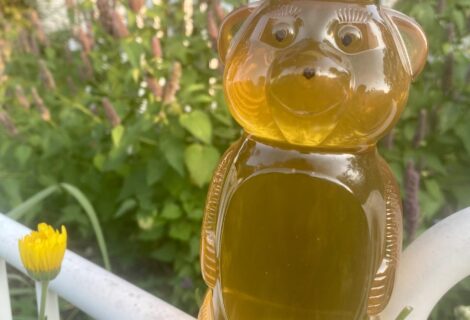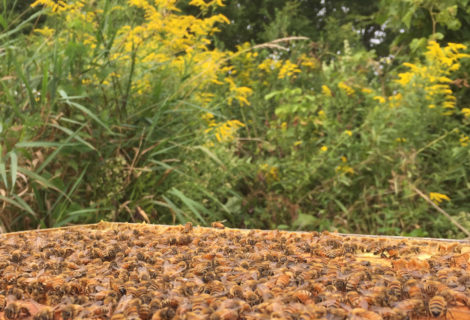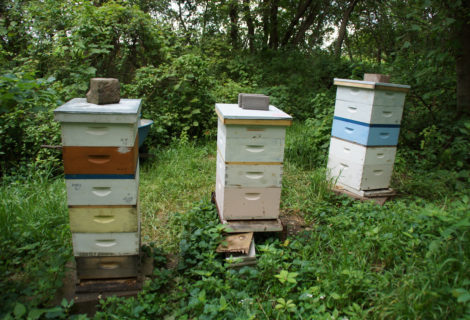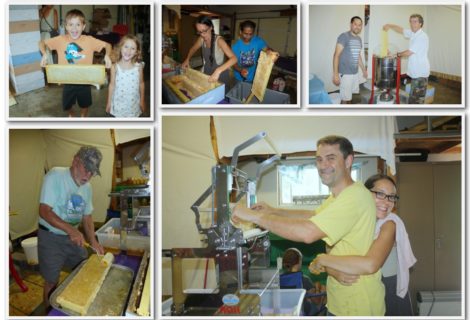Hot Bees
My father sent me an email with the subject “Hot Bees” the other day. It’s true – we’ve had a spell of hot & humid weather. If it was hot and dry air, that would be right up the bees alley – they like to forage under those conditions. But it’s been very high humidity/dew points here the past several days. It is difficult for the bees to ventilate the hive adequately under these conditions and “dry down” the honey. Normally, if it is quite hot out and the nest is getting too uncomfortable for the bees or the brood temperature is getting much above 95 F (93-95F continuously is needed for the developing brood), then the bees collect extra water and start more fanning inside the hive and at the hive entrance.
 But when humidity approaches 100%, then they can’t evaporate much more water vapor into the air for cooling purposes. So what they have to do is start “bearding”. You can see that in the first couple photos here. A lot of bees will exit the hive and hang out in front, creating a “beard” on the boxes. This helps because even at a resting metabolic rate, the bees are still generating heat and exhaling water vapor during respiration. If they all stay in the hive during hot and humid days, that just adds to the problem, and the brood can die or suffer developmental defects. So they will hang outside the front of the hive until they bring the environmental conditions inside back into balance. Honey bees are continually regulating the environment in the nest – this allows them to have a functioning social colony where thousands of them share a small space, as well as survive the winter cold.
But when humidity approaches 100%, then they can’t evaporate much more water vapor into the air for cooling purposes. So what they have to do is start “bearding”. You can see that in the first couple photos here. A lot of bees will exit the hive and hang out in front, creating a “beard” on the boxes. This helps because even at a resting metabolic rate, the bees are still generating heat and exhaling water vapor during respiration. If they all stay in the hive during hot and humid days, that just adds to the problem, and the brood can die or suffer developmental defects. So they will hang outside the front of the hive until they bring the environmental conditions inside back into balance. Honey bees are continually regulating the environment in the nest – this allows them to have a functioning social colony where thousands of them share a small space, as well as survive the winter cold.
Today it is raining, so that makes it difficult for them to beard outside. On the other hand, because of the rain and clouds, it is cooler out – 73 F now. That helps balance things out. Another thing that helps is venting the hives more. We put sticks as spacers between the inner cover and telescoping outer cover on top of the hive. This allows more air to vent from under the outer cover, but still keeps the cover from blowing off or rain getting in. We added a few thicker sticks over the last few days.
Wet Year
This has been a wetter spring and summer for us. Except for a few dry weeks in June, we’ve gotten significantly more than average rainfall. The land and grass is quite lush, but it does not provide prime conditions for making honey. The bees forage best when it is sunny and calm. Repetitious rains do wash out the nectar of certain flowers, but the bigger issue is just the humid, wet weather pattern. Different flowers flowers produce nectar at different times of day and they can usually replenish their nectaries fairly quick, but it all depends. Rain and wind can knock petals and pollen off of flowers and get into the nectaries, diluting the nectar even more.
It does not seem like as strong of a “honey flow” this year, at least for our Iowa hives. And this could be part of the reason. The other part is likely due to the very small wild basswood bloom we had. In normal years, the basswoods their put out a profuse bloom and the honey bees can gather a lot of nectar from them in a couple weeks time. The hummingbirds seem to know it as well. There will be many dozens of them working the feeders that line my folk’s porch, but when the basswoods bloom, they disappear for a couple weeks since they prefer basswood nectar to the sugar solution in the feeders.
This year was different, however. There never was very many hummingbirds at the front porch. Possibly they knew there would no a big basswood bloom in the area and chose to live in a different area? American basswoods (part of the Linden family) are irregular and may put out larger blooms every 1 to 3 years. Why all the individual trees in our apiary area have seemed to synchronize their reproductive activity is a bit baffling to me though. There are many mysteries in nature. We’ll see how it influences our honey production and flavor later this summer.
Update
 The same day I wrote this up, we had 3.5 inches of rain. I went to check on the bees later, and although the temps were lower, not all the bees were back in the hive. Some of them were pretty soggy. I hope that they are able to dry out after getting so wet. The bee in the photo here clinging to the hive, but the rain still had drenched them.
The same day I wrote this up, we had 3.5 inches of rain. I went to check on the bees later, and although the temps were lower, not all the bees were back in the hive. Some of them were pretty soggy. I hope that they are able to dry out after getting so wet. The bee in the photo here clinging to the hive, but the rain still had drenched them.
The other hive was on a iron post stand, and a number of bees were forming an inverted pyramid underneath their hive to avoid the raid. Pretty smart!









Recent Comments